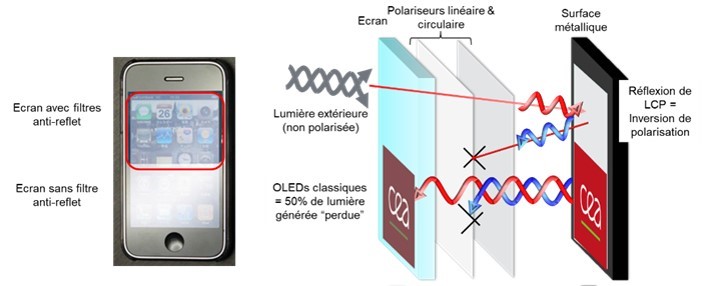Anti-glare filters installed in OLED (Organic Light-Emitting Diode) screens significantly reduce the quality of light produced by those screens (see diagram). The filters stop the reflection of external light (the sun, public lighting) by the OLED panel, but unless the device emits circularly polarized light (see paragraph below), 50% of the light intensity produced by the diode is lost.
In 2016, research led by researchers from CEA-Joliot (Feuillastre et al., JACS, 2016) developed purely organic electroluminescent materials (without rare metals) which, through their design and structure, exploit three properties that improve their ratio of energy consumed to quality of light produced:
- Thermally Activated Delayed Fluorescence (TADF)[1], which can theoretically transform all the electrical energy into light;
- aggregation-induced emission enhancement, where the efficiency of the luminophores increases further when they are aggregated and arranged in a solid, unlike classic luminophores, for which efficiency plummets in this state (Figure 1);
- emission of circularly polarized light (CPL)[2], which can pass through the anti-glare filters applied to screens without attenuating the light produced by the OLED panel, a very rare phenomenon in the organic world.

Diagram showing the reduction in efficiency of OLED screens caused by anti-glare filters
© L. Favereau (CNRS/Université de Rennes)
Whereas classic CPL-emitting fluorophores are intrinsically chiral (high cost of synthesis), the "chiral perturbation" concept enables chiroptic properties to be given to an active chromophore by coupling it with a commercially available chiral unit** that already has the desired spatial geometry (Figure 2). In the present study, researchers associated with CEA-Iramis and CEA-Leti synthesized a series of new luminophores to carry out the first systematic analysis of the relationship between structure and properties for this type of organic material and to understand the parameters affecting the efficacy of the chiral perturbation and therefore the ability to improve the properties of these materials. Some of the molecules obtained were then integrated into the first circularly polarized light-emitting OLEDs, in an architecture enabling them to be integrated into high-resolution portable display devices.
Optimization of the chiral perturbation was essential to enable the teams to continue working to improve the quality of light produced and obtain a truly revolutionary OLED material that could be used for industry.

Figure 1: Illustration of the enhanced light
emission of the new luminophores when aggregated (from left to right: increase
in concentration) © L. Frédéric (SCBM/CEA)

Figure 2: Chemical formulation of the new chromophores, integrating the 3 properties that improve the "energy consumed/quality of light produced" ratio in display systems © G. Pieters (SCBM/CEA)
[1]Electroluminescence relies on the excitation of a luminophore by electrical energy; the luminophore "de-excites" by emitting light. Classic luminophores "convert" 25% of their electrical energy into light, whereas thermally-activated delayed fluorescence (TADF) luminophores de-excite more efficiently and could theoretically reach efficiencies of 100%.
[2]Circularly Polarized Light: Polarizing light is like arranging the photons in the luminous flux: in a "classic" flux, the photons move randomly, but this is not the case with polarized light. "Circularly polarized" means that the photons follow the same circular trajectory along the luminous flux.